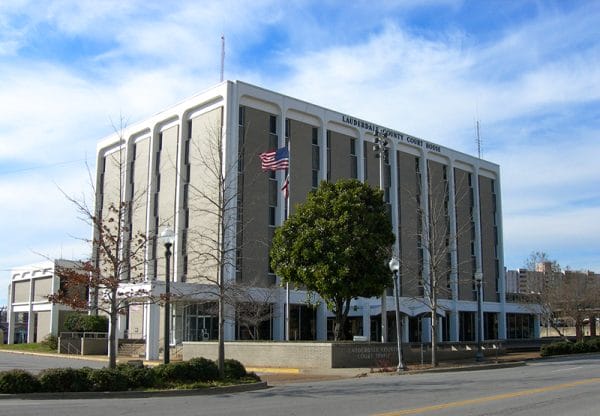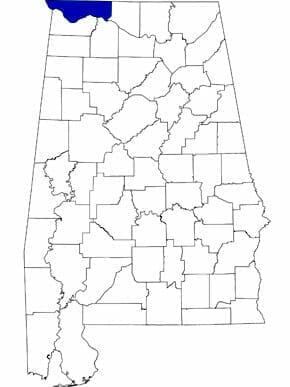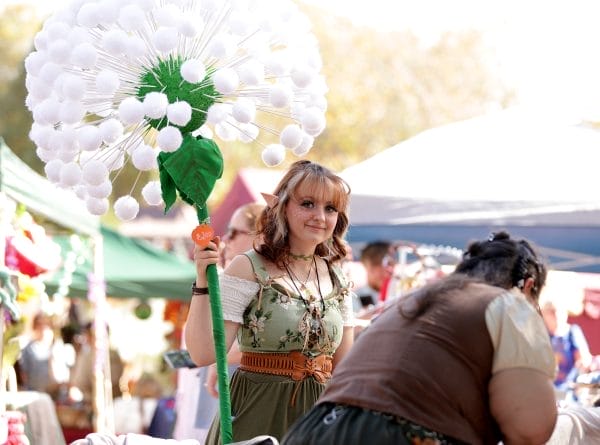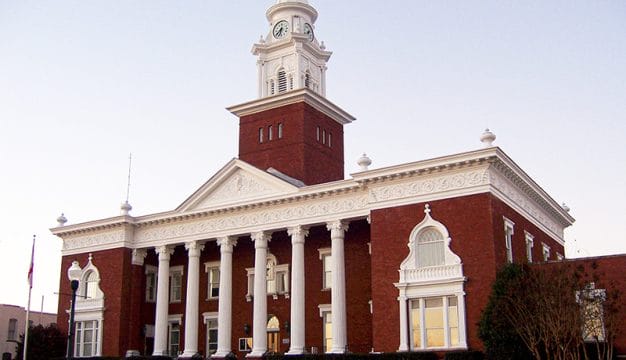Lauderdale County
 W. C. Handy Birthplace, Museum, and Library
Located in northwest Alabama, Lauderdale County was home to W. C. Handy, sometimes referred to as the “Father of the Blues,” as well as five Alabama governors: Hugh McVay, Robert Miller Patton, George Smith Houston, Edward A. O’Neal, and Emmet O’Neal. The county is also home to one of Alabama’s best examples of prehistoric earthen mounds, built by Indians of the Woodland period. The county is governed by an elected five-member commission and contains seven incorporated communities, including the city of Florence.
W. C. Handy Birthplace, Museum, and Library
Located in northwest Alabama, Lauderdale County was home to W. C. Handy, sometimes referred to as the “Father of the Blues,” as well as five Alabama governors: Hugh McVay, Robert Miller Patton, George Smith Houston, Edward A. O’Neal, and Emmet O’Neal. The county is also home to one of Alabama’s best examples of prehistoric earthen mounds, built by Indians of the Woodland period. The county is governed by an elected five-member commission and contains seven incorporated communities, including the city of Florence.
- Founding Date: February 6, 1818
- Area: 661 square miles
- Population: 92,870 (2020 Census estimate)
- Major Waterways: Tennessee River
- Major Highways: U.S. 72, U.S. 43
- County Seat: Florence
- Largest City: Florence
History
 Lauderdale County Courthouse
Lauderdale County’s earliest known inhabitants were pre-historic Native Americans who left behind great earthen mounds along the Tennessee River, although many were subsequently covered by water when dams were built during the early twentieth century. One of the largest and most well-known mounds is located in Lauderdale County. The county was one of eight created on February 6, 1818, by the legislature of the Territory of Alabama from land ceded to the United States by the Cherokees and Chickasaws in a treaty in 1816. The county was named for Tennessean Lt. Col. James Lauderdale, who died December 23, 1814, from wounds he received in the Battle of Talladega. The earliest settlers came from Tennessee, Kentucky, Georgia, the Carolinas, and Virginia. Some of the first settlements and towns included Waterloo, Florence, Rogersville, and Green Hill.
Lauderdale County Courthouse
Lauderdale County’s earliest known inhabitants were pre-historic Native Americans who left behind great earthen mounds along the Tennessee River, although many were subsequently covered by water when dams were built during the early twentieth century. One of the largest and most well-known mounds is located in Lauderdale County. The county was one of eight created on February 6, 1818, by the legislature of the Territory of Alabama from land ceded to the United States by the Cherokees and Chickasaws in a treaty in 1816. The county was named for Tennessean Lt. Col. James Lauderdale, who died December 23, 1814, from wounds he received in the Battle of Talladega. The earliest settlers came from Tennessee, Kentucky, Georgia, the Carolinas, and Virginia. Some of the first settlements and towns included Waterloo, Florence, Rogersville, and Green Hill.
Florence was named county seat of Lauderdale County at its founding and remains so today. The initial court sessions were held in the home of William S. Fulton, the county’s first judge, until the first courthouse was completed in 1822. The building, a two-story structure, had a wide portico with 10 columns and a tall steeple with a cupola containing a clock. It was demolished in 1899 and replaced with a more modern structure. According to local recollection, the second, red brick courthouse rested on the same foundation as the first, and the columns from the first courthouse were also reused on the second structure. This courthouse was in use until 1965, when the present-day courthouse was built.
Major Cities and Demographics
 Florence, 1942
According to 2020 Census estimates, the population of Lauderdale County was 92,870. Of that total, 85.9 percent of respondents identified themselves as white, 10.2 percent as African American, 2.8 percent as Hispanic, 2.4 percent as two or more races, 0.6 percent as Asian, 0.4 percent as American Indian, and 0.1 as Native Hawaiian and Other Pacific Islander. The county seat Florence is largest city in Lauderdale County with an estimated population of 40,652. Other significant population centers include St. Florian, Rogersville, Killen, and Lexington. The median household income was $48,428, compared with $52,035 for the state as a whole, and the per capita income was $28,540, compared with $28,934 for the state as a whole.
Florence, 1942
According to 2020 Census estimates, the population of Lauderdale County was 92,870. Of that total, 85.9 percent of respondents identified themselves as white, 10.2 percent as African American, 2.8 percent as Hispanic, 2.4 percent as two or more races, 0.6 percent as Asian, 0.4 percent as American Indian, and 0.1 as Native Hawaiian and Other Pacific Islander. The county seat Florence is largest city in Lauderdale County with an estimated population of 40,652. Other significant population centers include St. Florian, Rogersville, Killen, and Lexington. The median household income was $48,428, compared with $52,035 for the state as a whole, and the per capita income was $28,540, compared with $28,934 for the state as a whole.
Economy
 Lauderdale County Cattle
The earliest settlers of Lauderdale County found the level, fertile land good for farming, and agriculture was the prevailing industry until well into the twentieth century. Early farmers grew corn, wheat, and oats and raised cattle and hogs. By 1820, however, cotton had taken over as the major cash crop, and cotton plantations sprang up throughout the county. Textile mills and other cotton-related industries soon followed. Iron mining and manufacturing became established as well. Industrialization, especially the iron industry, was given a significant boost in the late nineteenth century with the completion of a series of locks and dams along the Tennessee River. In the 1930s, the Tennessee Valley Authority (TVA) constructed a series of dams on the Tennessee, providing Lauderdale and other counties with abundant hydroelectric power. Today, the principal industries in Lauderdale County center on the production of primary and fabricated metals as well as chemical and rubber products. The commercial and economic center of Lauderdale County is located in the metropolitan area in northwest Alabama known as “The Shoals.”
Lauderdale County Cattle
The earliest settlers of Lauderdale County found the level, fertile land good for farming, and agriculture was the prevailing industry until well into the twentieth century. Early farmers grew corn, wheat, and oats and raised cattle and hogs. By 1820, however, cotton had taken over as the major cash crop, and cotton plantations sprang up throughout the county. Textile mills and other cotton-related industries soon followed. Iron mining and manufacturing became established as well. Industrialization, especially the iron industry, was given a significant boost in the late nineteenth century with the completion of a series of locks and dams along the Tennessee River. In the 1930s, the Tennessee Valley Authority (TVA) constructed a series of dams on the Tennessee, providing Lauderdale and other counties with abundant hydroelectric power. Today, the principal industries in Lauderdale County center on the production of primary and fabricated metals as well as chemical and rubber products. The commercial and economic center of Lauderdale County is located in the metropolitan area in northwest Alabama known as “The Shoals.”
Employment
According to 2020 Census estimates, the workforce in Lauderdale County was divided among the following industrial categories:
- Educational services, and health care and social assistance (22.4 percent)
- Retail trade (14.7 percent)
- Manufacturing (13.8 percent)
- Arts, entertainment, recreation, and accommodation and food services (9.7 percent)
- Professional, scientific, management, and administrative and waste management services (7.7 percent)
- Construction (7.0 percent)
- Transportation and warehousing, and utilities (6.1 percent)
- Public administration (5.2 percent)
- Other services, except public administration (4.6 percent)
- Finance and insurance, and real estate, rental, and leasing (4.1 percent)
- Wholesale trade (2.4 percent)
- Information (1.5 percent)
- Agriculture, forestry, fishing and hunting, and extractive (0.8 percent)
Education
The Lauderdale County school system oversees 13 primary and secondary schools. Florence City Schools oversee nine primary and secondary schools. Located in Florence, the University of North Alabama is a traditional four-year institution offering undergraduate and graduate degrees in the arts and sciences, business, education, and nursing. Heritage Christian University in Florence offers degrees in Bible education.
Geography
 Lauderdale County Map
Comprising just over 660 square miles, Lauderdale County is located in the northwest corner of the state. The majority of the county is located in the Highland Rim physiographic section, although the East Gulf Coastal Plain physiographic section makes up a portion of the western part of the county. The landscape is dotted by oak and pine forests, which grow out of the limestone soils that cover the county’s valleys and upland ridges. Lauderdale County is bordered by the state of Tennessee to the north, Limestone County to the east, Colbert and Lawrence Counties to the south, and the state of Mississippi to the west.
Lauderdale County Map
Comprising just over 660 square miles, Lauderdale County is located in the northwest corner of the state. The majority of the county is located in the Highland Rim physiographic section, although the East Gulf Coastal Plain physiographic section makes up a portion of the western part of the county. The landscape is dotted by oak and pine forests, which grow out of the limestone soils that cover the county’s valleys and upland ridges. Lauderdale County is bordered by the state of Tennessee to the north, Limestone County to the east, Colbert and Lawrence Counties to the south, and the state of Mississippi to the west.
The Tennessee River and its many tributaries flow throughout Lauderdale County. The river crosses the fall line just south of Lauderdale County in Muscle Shoals, separating the Upper Tennessee and the Lower Tennessee. The Tennessee River is considered among the most biologically diverse rivers in the entire United States, with many fish and mussel species at risk. The river offers a range of economic and recreational opportunities for Lauderdale County.
U.S. Highway 72 and U.S. Highway 43 serve as the county’s main transportation routes. U.S. Highway 72 runs east-west along the southern border of the county, and U.S. Highway 43 runs north-south through the middle of the county. There are no public airports in Lauderdale County.
Events and Places of Interest
 Rosenbaum House
There are a number of recreational opportunities in Lauderdale County. Named for Gen. Joseph Wheeler, Joe Wheeler State Park, located two miles west of Rogersville, affords visitors opportunities to golf, camp, boat, fish, hike, and picnic. The park also has a convention center, which hosts various functions throughout the year. The series of locks and dams along the Tennessee River created a number of lakes, three of which are located in Lauderdale County. Pickwick Lake, Wilson Lake, and Wheeler Lake provide scenic views and outdoor recreational opportunities for visitors. Shoal Creek Preserve is a nature reserve located just north of St. Florian that is managed by the Forever Wild Land Trust. It encompasses 298 acres of woodlands, open fields, and waterways.
Rosenbaum House
There are a number of recreational opportunities in Lauderdale County. Named for Gen. Joseph Wheeler, Joe Wheeler State Park, located two miles west of Rogersville, affords visitors opportunities to golf, camp, boat, fish, hike, and picnic. The park also has a convention center, which hosts various functions throughout the year. The series of locks and dams along the Tennessee River created a number of lakes, three of which are located in Lauderdale County. Pickwick Lake, Wilson Lake, and Wheeler Lake provide scenic views and outdoor recreational opportunities for visitors. Shoal Creek Preserve is a nature reserve located just north of St. Florian that is managed by the Forever Wild Land Trust. It encompasses 298 acres of woodlands, open fields, and waterways.
The Indian Mound and Museum in Florence is a popular historic attraction. The ancient mound reaches a height of 42 feet, the largest of several in the Tennessee Valley. The nearby museum features displays of tools, ornaments, pottery, and other artifacts along with exhibits on the mound builders of the Woodland tradition.
 Dandelion Fairy
The city of Florence offers visitors numerous historic districts and structures. Completed in 1940, the Rosenbaum House, built by famed architect Frank Lloyd Wright, was originally designed for a two-acre site overlooking the Tennessee River and is constructed of natural materials with large areas of glass to take advantage of the view. Now listed on the National Register of Historic Places, the home is open for guided tours. The W. C. Handy Home and Museum pays tribute to William Christopher “W. C.” Handy. His log-cabin birthplace contains late-nineteenth century reproduction furnishings, and the adjoining museum features Handy’s trumpet and piano as well as sheet music, photographs, letters, and awards relating to the musician’s life. Florence also is home to several historic districts, located at various points in the city, that are listed on the National Register of Historic Places. Pope’s Tavern Museum, located near the UNA campus, was originally built as a stagecoach stopover and tavern in 1811 and served as a hospital for Confederate and Union soldiers. Now a museum, the tavern offers visitors exhibits of period furnishings, kitchen utensils, tools, firearms, Civil War uniforms, photos, letters, and pioneer artifacts.
Dandelion Fairy
The city of Florence offers visitors numerous historic districts and structures. Completed in 1940, the Rosenbaum House, built by famed architect Frank Lloyd Wright, was originally designed for a two-acre site overlooking the Tennessee River and is constructed of natural materials with large areas of glass to take advantage of the view. Now listed on the National Register of Historic Places, the home is open for guided tours. The W. C. Handy Home and Museum pays tribute to William Christopher “W. C.” Handy. His log-cabin birthplace contains late-nineteenth century reproduction furnishings, and the adjoining museum features Handy’s trumpet and piano as well as sheet music, photographs, letters, and awards relating to the musician’s life. Florence also is home to several historic districts, located at various points in the city, that are listed on the National Register of Historic Places. Pope’s Tavern Museum, located near the UNA campus, was originally built as a stagecoach stopover and tavern in 1811 and served as a hospital for Confederate and Union soldiers. Now a museum, the tavern offers visitors exhibits of period furnishings, kitchen utensils, tools, firearms, Civil War uniforms, photos, letters, and pioneer artifacts.
Other attractions and events in Lauderdale County include the Kennedy-Douglass Center for the Arts, the W. C. Handy Music Festival, the Children’s Museum of the Shoals, the Edith Newman Culver Memorial Museum, and the annual Alabama Renaissance Faire.
Further Reading
- The Heritage of Lauderdale County, Alabama. Clanton, Ala.: Heritage Publishing Consultants, 1999.
External Links
- Lauderdale County
- Lauderdale County School District
- Florence-Lauderdale Public Library
- City of Florence
- City of Killen
- City of Lexington
- Town of Rogersville
- Town of St. Florian
- Shoals Chamber of Commerce
- University of North Alabama
- National Register of Historic Places: Lauderdale County
- Rosenbaum House
- Visit The Shoals
- Visit North Alabama
- Joe Wheeler State Park
- Florence Arts and Museums
- Children's Museum of the Shoals
- W. C. Handy Museum
- Alabama Renaissance Faire
- Wilson Dam



